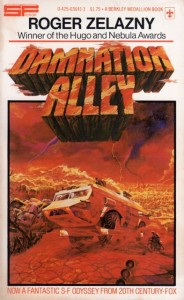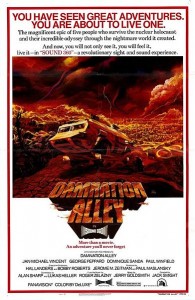
Damnation Alley is a 1969 novel written by Roger Zelazny. It first appeared as a novella two years earlier in the October 1967 issue of Galaxy Magazine, but for review purposes (and because it is the copy I have), I am refereeing to the Berkley Medallion Book edition printed in 1977. This is convenient as it is also the same book released in concurrence with the release of the film by the same name, which is also mentioned here.
I should start by confessing that my first experience with the story was with the 1977 film version directed by Jack Smight and starring Jan-Michael Vincent and George Peppard. The screenplay was written by Alan Sharp and Lukas Heller, but the novel by Zelazny was still credited in the film. My introduction to the book version came much later. I should also point out that another science fiction film was released just five months earlier which might have played a role in Damnation Alley’s short stint in the box office. It makes sense that by premiering a movie in the wake of the cinematic juggernaut Star Wars, pretty much everything else is going to get overshadowed.
Though I’m a fan of the Damnation Alley movie and will often refer to it here, my primary focus is in the literary tale. Zelazny’s story centers around our protagonist named Hell Tanner. He’s a convicted murderer who also happens to be a skilled driver from years of smuggling. Following a nuclear holocaust, America is a wasteland left with only a smattering of surviving civilizations. Boston is crumbling under the weight of a deadly plague and the nation of California possesses the only vaccine that can save the dying state. Tanner is given an opportunity to have his record erased if he makes the ultimate run across America through “Damnation Alley” and become a hero.
The most inherent problem with the book is the raw character development, or lack thereof. Tanner is a bad dude who does bad things throughout the story. The name Hell overshadows the toughness to the point where he becomes a caricature of bad guys facing redemption. The reader never gets a comfortable chance to cheer for him because he is in constant conflict with himself (typical for this archetype), yet the end result of most conflicts bares little impact to the general plot and every action scene seems gratuitous.

The literary version of Tanner is quite a contrast to the character in the film as is the overall plot. The name Hell is replaced by Jake, and instead of being a convicted killer, he is a Lieutenant in the Air Force. As one of the ICBM button pushers who took part in the Doomsday event that tilted the planet on it axis (George Peppard’s character Major Denton is the other), guilt ridden Tanner is a mixed bag of emotions throughout the film.
Instead of the heroic task of delivering a vaccine to a dying state, the film version simply has the survivors trek across the nuclear wasteland in hopes of finding other survivors. A radio transmission from Albany, New York is all it takes. It is enough to give the two men hope, so off they go. Sure the premise in the novel is far more believable than the film, but because of Zelazny’s bland characters, the story in the book is handcuffed by the superfluous subplots we usually see in film versions.
Finally I’d like to bring up the true star of Damnation Alley. The Landmaster was an awesome vehicle that stole every scene of the film it appeared in. The “car” was far less impacting in the book version, but in my opinion, it was still the most intriguing element in the book. Yet again, there are some noticeable differences that make or break the story. According to Zelazny:
“There were no windows in the vehicle, only screens which reflected views in every direction, including straight up and the ground beneath the car. Tanner sat within an illuminated box which shielded him against radiation. The “car” that he drove had eight heavily treaded tires and was thirty-two feet in length. It mounted eight fifty-caliber automatic guns and four grenade-throwers. It carried thirty armor-piercing rockets which could be discharged straight ahead or at any elevation up to forty degrees from the plane. Each of the four sides, as well as the roof of the vehicle, housed a flamethrower. Razor-sharp “wings” of tempered steel – eighteen inches wide at their bases and tapering to points, an inch and a quarter thick where they ridged – could be moved through a complete hundred-eighty-degree arc along the sides of the car and parallel to the ground, at a height of two feet and eight inches. When standing at a right angle to the body of the vehicle – eight feet to the rear of the front bumper – they extended out to a distance of six feet on either side of the car. They could be couched like lances for a charge. They could be held but slightly out from the sides for purposes of slashing whatever was sideswiped. The car was bullet-proof, air conditioned, and had its own food locker and sanitation facilities. A long barreled .357 Magnum was held by a clip on the door near the driver’s left hand. A 30.06, a .45-caliber automatic, and six hand grenades occupied the rack immediately above the front seat.”

As awesome as the “car” sounds, this description does not entirely reflect the vehicle from the film. The weaponry could be slingshots and it wouldn’t matter, but the most noticeably different aspect might be the fabulous tri-tire configuration that catches my eye every time I see the movie. I did the math. The “eight heavily treaded tires” do not make for visual sense from a reader’s aspect. No, the design used in the film is by far the better choice. Popular Science even did a piece in the March 1977 issue titled “Monster Vehicle” about the design. Proof: even before the movie came out, the star was born.
Roger Zelazny earned and won many awards as a writer over the years, but Damnation Alley was obviously not one of his most popular stories. The book is hard to read if you want to take the characters seriously. But it’s just as hard to condemn a piece of work that inspired such a cult classic film. And for that alone, I must say the journey across Damnation Alley is an important adventure in science fiction and well worth a look.










